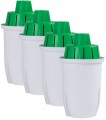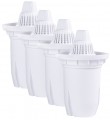Types of filtration provided by the cartridge. This parameter takes into account both the types of pollution that the product is able to cope with, and some features of its operation.
—
Mechanical(impurities, sand). Purification from mechanical impurities — insoluble particles larger than a certain size (see "Pollution clipping"). The simplest cleaning method that can be achieved with relatively simple and inexpensive filter elements.
—
Carbon(active chlorine, smell, taste). Purification through the use of
activated carbon or other similar sorbent. Such a sorbent absorbs foreign substances dissolved in water, providing cleaning at the chemical level.
—
Colloidal iron (rust). Purification of colloidal iron — particles suspended in water, which consist of insoluble iron compounds and give the water a characteristic "rusty" shade with a corresponding taste and smell. Some of this iron can be removed from the water by mechanical filtration, but additional chemical cleaning methods can be provided to increase efficiency. Therefore, this type of filtering is rendered separately.
—
Hardness salts (limescale)). Removal of calcium and magnesium salts, which make water hard and lead to the formation of scale on heating elements (in particular, heating elements of washing
...machines and dishwashers). Also note that excessive water hardness reduces the effectiveness of detergents. To remove hardness salts, different methods can be used, depending on the composition of the cartridge (see the relevant paragraph). So, ion-exchange resins take calcium and magnesium ions from water, replacing them with sodium ions; polyphosphate crystals form soluble compounds with hardness salts that do not limescale; and osmotic membranes (see "Application") filter out salts at the molecular level.
— Heavy metal ions. Removal from water of ions of various heavy metals that are harmful to humans — mercury, cadmium, plumbum, etc. Such purification can be carried out both chemically (reagent) and osmotically (see "Application").
— UV cleaning (bacteria). Purification of water from pathogenic bacteria, fungi and other microorganisms, carried out by exposure to ultraviolet radiation. Such radiation is detrimental to microorganisms, while it does not affect the chemical properties of water and does not affect its quality.
— Mineralization. Saturation of filtered water with minerals useful for the human body. This function is often provided in reverse osmosis systems (see "Application"): osmotic purification removes not only harmful, but also useful impurities from the water, as a result, the water turns out to be "dead", which does not carry any benefit (and it may even taste unpleasant). Mineralization allows you to compensate for this moment.
— Improving taste. This item includes cartridges installed after post-filters in reverse osmosis systems. These can be carbon, bio-ceramic and other similar filter elements designed to saturate the taste of already purified water. Advanced implementations of such cartridges make it possible to obtain water that is as close as possible to natural water in its structure and taste.
— Nitrates. Purification of water from nitrates — salts of nitric acid. Nitrates are widely used as fertilizers; most of them are processed by plants into harmless compounds, but unused residues can enter the water, and such substances are harmful to the human body. Purification can be carried out both by reverse osmosis (see "Purpose"), and chemically — due to substances that connect nitrates and do not allow them to pass the filter.
— Pesticides. Pesticides are toxic chemicals used to combat harmful flora and fauna — weeds, insects, rodents, etc. Most of these compounds are also harmful to humans. Removal of pesticides can be provided by adsorption (absorbing) filters or reverse osmosis systems (see "Application").
— Petroleum products. Oil and various substances obtained from it (gasoline, kerosene, diesel fuel, fuel oil, etc.). Poisonous when taken orally. Oil products do not dissolve in water, but may be present as a suspension or film on the surface. They are removed mainly by adsorption or reverse osmosis (see "Application").
